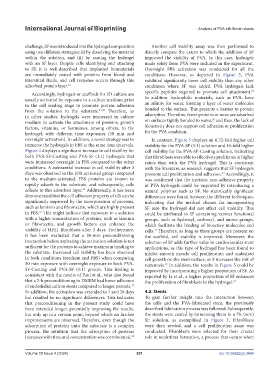Page 299 - IJB-10-4
P. 299
International Journal of Bioprinting Analysis of PVA-silk fibroin stents
challenge, SF was introduced into the hydrogel composition Another cell viability assay was then performed to
using two different strategies: (i) by dissolving the material directly compare the extent to which the addition of SF
within the solution, and (ii) by coating the hydrogel improved the viability of PVA. In this case, hydrogels
with an SF layer. Despite cells identifying and attaching made solely from PVA were included in the experiment.
to SF, it is well-described that implanted biomaterials Overnight FBS activation was conducted for all the
are immediately coated with proteins from blood and conditions. However, as depicted in Figure 5, PVA
interstitial fluids, and cell response occurs through this exhibited significantly lower cell viability than any other
adsorbed protein layer. 28 conditions where SF was added. PVA hydrogels lack
32
Accordingly, hydrogels or scaffolds for 3D culture are specific peptides required to promote cell attachment.
usually activated by exposure to a culture medium prior In addition, hydrophilic materials, such as PVA, have
to the cell seeding stage to promote protein adhesion an affinity for water, forming a layer of water molecules
from the solution to the substrate. 25,29 Therefore, as bonded to the surface. This presents a barrier to protein
in other studies, hydrogels were immersed in culture adsorption. Therefore, fewer proteins or none are adsorbed
28
medium to activate the attachment of proteins, growth on surfaces tightly bonded to water, and thus, the lack of
factors, vitamins, or hormones, among others, to the bioactivity does not support cell adhesion or proliferation
hydrogel, with different time exposures (30 min and for the PVA condition.
overnight activation). In addition, a novel strategy was to In contrast, Figure 5 displays an 8.72-fold higher cell
immerse the hydrogels in FBS at the same time intervals. viability for the PVA-SF (1:1) solution and 10-fold higher
Figure 4 displays a significant increase in cell viability for cell viability for the PVA-SF-Coating solution, indicating
both PVA-SF-Coating and PVA-SF (1:1) hydrogels that that fibroblasts were able to effectively proliferate at higher
were immersed overnight in FBS compared to the other ratios than with the PVA hydrogel. This is consistent
conditions. A substantial increase in cell viability after 3 with the literature, as research suggests that SF hydrogels
days was observed in the FBS-activated group compared promote cell proliferation and adhesion. Accordingly, it
33
to the medium-activated. FBS proteins are known to was confirmed that the intrinsic non-adhesive property
rapidly adsorb to the substrate, and subsequently, cells of PVA hydrogels could be improved by introducing a
adhere to this adsorbed layer. Additionally, it has been natural polymer such as SF. No statistically significant
30
demonstrated that the cell adhesion property of silk can be differences were found between the different techniques,
significantly improved by the incorporation of proteins, indicating that the method chosen for incorporating
such as laminin and fibronectin, which are highly present SF into the hydrogel did not affect cell viability. This
in FBS. This might indicate that exposure to a solution could be attributed to SF containing various functional
31
with a higher concentration of proteins, such as laminin groups, such as hydroxyl, carboxyl, and amine groups,
or fibronectin, and growth factors can enhance the which facilitate the binding of bioactive molecules and
viability of HFL1 fibroblasts after 3 days. Furthermore, cells. Therefore, as long as these groups are present on
34
it has been evaluated that a 30-min preconditioning the scaffold, cell viability is improved. Moreover, the
interaction before aspirating the activation solution is not selection of SF adds further value in cardiovascular stent
sufficient for the proteins to achieve maximum binding to applications, as this type of hydrogel has been found to
the substrate. Increased cell viability has been observed inhibit smooth muscle cell proliferation and undesired
in both conditions (medium and FBS) when comparing cell growth on the stent surface, as it increases the risk of
30 min exposure with overnight exposure in both PVA- restenosis. In addition, the results in Figure 5 could be
15
SF-Coating and PVA-SF (1:1) groups. This finding is improved by incorporating a higher proportion of SF. As
consistent with the results of Paul et al., who also found reported by Li et al., a higher proportion of SF enhances
that a 2-h preconditioning in DMEM had lower adhesion the proliferation of fibroblasts in the hydrogel. 34
of endothelial cells to stents compared to longer periods.
29
In addition, the activation was extended to 7 and 28 days 4.2. Stents
but resulted in no significant differences. This indicates To gain further insight into the interaction between
that preconditioning in the present study could have the cells and the PVA-fabricated stent, the previously
been extended longer, potentially improving the results, described fabrication process was followed. Subsequently,
but only up to a certain point, beyond which no further the stents were coated by immersing them in a 7% (w/v)
improvements are observed. Therefore, even though the SF solution, as exemplified in Figure 2. Fibroblasts
adsorption of proteins onto the substrate is a complex were then seeded, and a cell proliferation assay was
process, the intuition that the adsorption of proteins conducted. Fibroblasts were selected for their crucial
increases with time and concentration was corroborated. 28 role in neointima formation, a process that occurs when
Volume 10 Issue 4 (2024) 291 doi: 10.36922/ijb.3444

